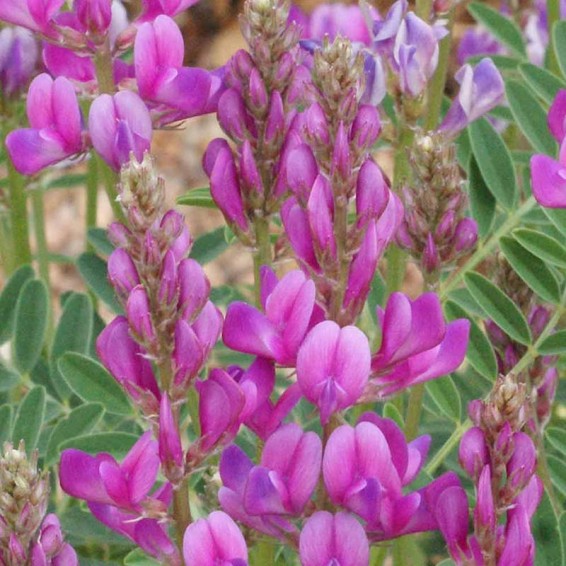Utah Sweetvetch Seeds
- HOW TO GROW
- FAST FACTS
- REVIEWS
HOW TO GROW
Sowing: This Hedysarum Boreale seed can be planted either in late fall or spring. The day before planting, pour 180 degrees F water over the Utah Sweetvetch seeds and soak them overnight to soften the seed coat and speed germination. Sow 1/4" deep and keep the soil consistently moist until germination. To start the seeds indoors, sow them in a flat 8 weeks before the last frost of spring; keep the soil lightly moist and at a temperature of 60-65 degrees F until germination. Transplant seedlings outdoors as soon as they can safely be handled.
Growing: Water the seedlings occasionally until they become established. Mature plants tolerate drought well, though they will appreciate water in extended periods of dry weather. Because of its extensive root system, this plant develops rather slowly and may not bloom until its third or fourth year of growth. Keep weeds down for the healthiest plants. Do not attempt to divide or transplant, since mature plants do not tolerate root disturbance well. This flower attracts butterflies and bees.
Harvesting: For fresh flowers, cut long stems of flowers that have just opened and place them in water immediately; strip the leaves that will fall below the water.
Seed Saving: This Hedysarum Boreale plant produces distinctive flat seed-pods connected in a chain-like formation. As soon as the pods turn brown, gather them and spread them out to dry completely. The dry, papery pods can either be removed or planted with the seeds they contain; they will not affect germination if the seed is properly scarified. Store the Utah wildflower seed in a cool, dry place.
FAST FACTS
Common Names: Recently begun to be listed as Xerochrysum bracteatum
Latin Name: Hedysarum boreale
Species Origin: US Native Wildflower
Type: Native Wildflowers
Life Cycle: Perennial
USDA Zones: 1, 2, 3, 4, 5, 6, 7, 8, 9
US Regions: Mountain, Arid/Desert, Plains/Texas, Northern
Seeds per Ounce: 30,600
Stratification: No Stratification
Germination Ease: No Stratification
Sunlight: Full Sun
Height: 24 Inches
Color: Pink, Purple
Bloom Season: Blooms Late Spring, Blooms Early Summer
utah sweetvetch
Great germination rate, they grow really fast and are a nice low-water alternative for pink sage or lupines.
Utah Sweetvetch
nice rock garden plant. first time ever seen offered.
DESCRIPTION
HOW TO GROW
Sowing: This Hedysarum Boreale seed can be planted either in late fall or spring. The day before planting, pour 180 degrees F water over the Utah Sweetvetch seeds and soak them overnight to soften the seed coat and speed germination. Sow 1/4" deep and keep the soil consistently moist until germination. To start the seeds indoors, sow them in a flat 8 weeks before the last frost of spring; keep the soil lightly moist and at a temperature of 60-65 degrees F until germination. Transplant seedlings outdoors as soon as they can safely be handled.
Growing: Water the seedlings occasionally until they become established. Mature plants tolerate drought well, though they will appreciate water in extended periods of dry weather. Because of its extensive root system, this plant develops rather slowly and may not bloom until its third or fourth year of growth. Keep weeds down for the healthiest plants. Do not attempt to divide or transplant, since mature plants do not tolerate root disturbance well. This flower attracts butterflies and bees.
Harvesting: For fresh flowers, cut long stems of flowers that have just opened and place them in water immediately; strip the leaves that will fall below the water.
Seed Saving: This Hedysarum Boreale plant produces distinctive flat seed-pods connected in a chain-like formation. As soon as the pods turn brown, gather them and spread them out to dry completely. The dry, papery pods can either be removed or planted with the seeds they contain; they will not affect germination if the seed is properly scarified. Store the Utah wildflower seed in a cool, dry place.
FAST FACTS
Common Names: Recently begun to be listed as Xerochrysum bracteatum
Latin Name: Hedysarum boreale
Species Origin: US Native Wildflower
Type: Native Wildflowers
Life Cycle: Perennial
USDA Zones: 1, 2, 3, 4, 5, 6, 7, 8, 9
US Regions: Mountain, Arid/Desert, Plains/Texas, Northern
Seeds per Ounce: 30,600
Stratification: No Stratification
Germination Ease: No Stratification
Sunlight: Full Sun
Height: 24 Inches
Color: Pink, Purple
Bloom Season: Blooms Late Spring, Blooms Early Summer
Reviews
Review
utah sweetvetch
Great germination rate, they grow really fast and are a nice low-water alternative for pink sage or lupines.
Review
Utah Sweetvetch
nice rock garden plant. first time ever seen offered.






